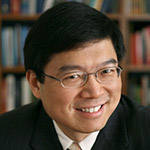By Beth Miller (from news.wustl.edu)
Lihong Wang, PhD, will receive the 2014 IEEE Biomedical Engineering Award, the highest honor conferred by the Institute of Electrical and Electronics Engineers (IEEE) in this field.

|
|
Wang, the Gene K. Beare Distinguished Professor of Biomedical Engineering at Washington University in St. Louis, was selected for his pioneering contributions to the field of photoacoustic tomography, a novel imaging technology he developed that uses light and sound to measure change. Wang earned a doctorate in electrical engineering from Rice University and bachelor’s and master’s degrees from Huazhong University of Science & Technology. |
“This award acknowledges Lihong Wang as an innovator of imaging technology that will benefit a wide range of important preclinical and clinical applications, including the detection of cancer,” said Mark Anastasio, PhD, professor and interim chair of the Department of Biomedical Engineering. “We are pleased that IEEE will recognize Lihong for his groundbreaking work.”
A leading researcher on new methods of biomedical imaging, Wang has received more than 34 research grants as the principal investigator with a cumulative budget of more than $41 million. His research on nonionizing biophotonic imaging has been supported by the National Institutes of Health, National Science Foundation (NSF), the U.S. Department of Defense, The Whitaker Foundation and the National Institute of Standards and Technology.
Wang and his lab were the founders of a new type of medical imaging that gives physicians a new look at the body’s internal organs. Called functional photoacoustic tomography, the technique relies on light and sound to create detailed pictures of tissue physiology deep inside the body and may eventually help doctors diagnose cancer earlier than is now possible and to more precisely monitor the effects of cancer treatment — all without the radiation involved in X-rays and CT scans or the expense of MRIs.
|
|
In September 2012, he received one of 10 NIH Director’s Pioneer Awards from among 600 applicants. The award supports individual scientists of exceptional creativity who propose pioneering — and possibly transforming — approaches to major challenges in biomedical and behavioral research.
He also has received the NIH FIRST, the NSF’s CAREER Award, the Joseph W. Goodman Book Writing Award, the Optical Society of America’s C. E. K. Mees Medal and IEEE’s Technical Achievement Award for seminal contributions to photoacoustic tomography and Monte Carlo modeling of photon transport in biological tissues and for leadership in the international biophotonics community. |
The School of Engineering & Applied Science at Washington University in St. Louis focuses intellectual efforts through a new convergence paradigm and builds on strengths, particularly as applied to medicine and health, energy and environment, entrepreneurship and security. With 82 tenured/tenure-track and 40 additional full-time faculty, 1,300 undergraduate students, 700 graduate students and more than 23,000 alumni, we are working to leverage our partnerships with academic and industry partners — across disciplines and across the world — to contribute to solving the greatest global challenges of the 21st century.